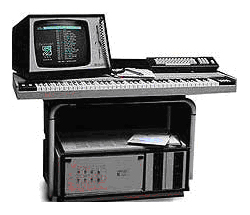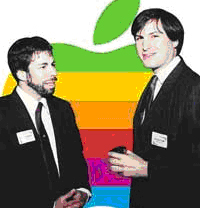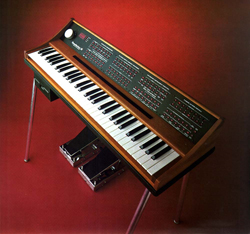
The Land of Woz
An early landmark came in January 1977, when Steve Wozniak and Steve Jobs set up Apple Computer; within a couple of months the Apple II – the word’s first PC to offer color graphics – became a rallying point for third-party hardware and software developers.
For example, by mid-year Micro Technology Unlimited started to ship music-synthesis software and 8-bit converter boards for the Apple II. (Within a year, is has been reported, MTU was delivering 500 Apple plug-in cards a month.)
Two short years later, the firm’s Delplay-12 became what many consider to be the world’s first pro-quality direct-to-disk DAW running on a personal computer. A sample-accurate editor followed soon.
For music creators, 1978 saw the public unveiling of a system that set new technical benchmarks: the New England Digital Synclavier.

Based on technology developed at Dartmouth College, it was arguably the world’s first real-time digital synthesis instrument.
Eventually, the Synclavier migrated from being a musical instrument into a full-on digital production environment; its combination of sampling/digital synthesis and disk-based recoding and playback was a remarkable success. Sadly, this company disappeared in the mid-Nineties.
Fairlight emerged in 1979 and introduced the Series I Computer Musical Instrument (CMI). It provided sampling and digital synthesis, a technology that would lead eventually to hard-disk recording systems and MFX Series digital audio workstations.
Unlike PC-based systems, both the Synclavier and CMI were based on minicomputers running proprietary operating systems.
In time, NED migrated its music-recording and post production DAW to operate on the Macintosh platform, but this did not forestall extinction. Yet today, Fairlight still uses propriety software and custom-developed hardware.

Meanwhile, back in the mass-market trenches, 1981 saw the introduction by IBM’s “Personal Computer” which, despite its wimpy 8088-based topology running at just 4.77 MHz and only 64 Kbytes of RAM, soon offered a powerful platform for hard-disk recorders and full-featured DAWs.
A year later Commodore announced its color-capable C-64, which become the world’s best-selling personal computer. In addition to recording/editing, the C-64’s integrated sound-synthesis offered powerful MDI-based functions.
Speaking of MIDI, 1983 saw the first public demonstration of Musical Instrument Digital Interface (MIDI), a format hashed out between a number of U.S. and Japanese MI manufacturers.
Now musical data could be scanned, stored and then initiated from a computer-based system, and even integrated with audio recording – the DAW suddenly grew an extra limb.
In the meantime, the PC rivals had been busy. In that same year, 1983, IBM launched the PC-XT with a 10 Mbyte hard drive.
The next year Apple countered with the Macintosh, a 68000-based system with a built-in nine-inch monitor, while 1985 saw the launch of the Atari 520 ST PC with built-in MIDI ports.
